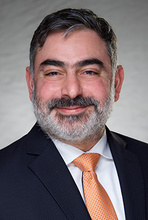UI Health Care researchers are collaborating with colleagues across the nation and the world to advance science and medicine. In just the past two weeks, UI researchers published new findings in high impact journals on the following topics:
- Treatment for metastatic eye cancer (NEJM)
- Molecular underpinnings of eye aging and disease (Cell)
- How a fungus adapts to infect human hosts (Nature Communications)
- Link between brain development and stunted growth in infants (Nature Human Behavior)
These papers showcase some of the innovative research that goes on throughout our academic medical center every day. The studies also highlight UI Health Care’s research strength across a wide sweep of disciplines—cancer, pediatrics, ophthalmology, neuroscience, and infectious disease—and illustrate a key aspect of the culture that drives much of our researchers’ success: collaboration.

Mohammed (Mo) Milhem, MBBS, clinical professor of internal medicine and Holden Chair of Experimental Therapeutics, was part of an international research team demonstrating that a new treatment for metastatic uveal (or ocular) melanoma improves the three-year survival rates for this rare but deadly form of eye cancer. The drug called tebentafusp was approved by the FDA in 2022 and is the only treatment for metastatic ocular melanoma, or ocular melanoma that cannot be surgically removed. The results from the phase 3 clinical trial, published in the New England Journal of Medicine on Oct. 21, found that after at least 36 months of follow-up, average survival was 21.6 months for patients treated with tebentafusp compared to 16.9 month for patients treated with standard of care medicines. The estimated percentage of patients surviving at three years was 27% in the tebentafusp group and 18% in the control group. Despite serving a relatively rural and less populated area or the country, the UI was one of the higher U.S. accrual sites for the trial. Milhem attributed this to the UI’s expertise in both ophthalmology overall and uveal melanoma in particular.
“We have one of the only uveal melanoma retinal specialists in the Midwest; Dr. Culver Boldt, who treats 7% of all uveal melanoma cases in the Midwest due to his unique expertise in managing these patients,” says Milhem, who also is director of the Melanoma Program with the UI Holden Comprehensive Cancer Center.

Alex Bassuk, MD, PhD, UI professor and chair of the Stead Family Department of Pediatrics, was part of a multi-institutional team led by Stanford University that used liquid biopsy proteomics and artificial intelligence (AI) to identify cellular drivers of aging and disease in eyes. In the study, published Oct.19 in Cell, the research team developed new techniques, which they used to analyze 6,000 proteins found in the liquid inside the eye. A technique called TEMPO (tracing expression of multiple protein origins), which integrates microvolume liquid-biopsy proteomics, single-cell transcriptomics, and AI, revealed the cellular origin of disease-driving proteins, and identified 26 proteins that could predict aging. Using these new tools, the researchers were able to identify proteins and cells associated with accelerate aging in three different eye diseases, revealing new potential targets for therapies. The researchers hope to apply the approach to fluids from other organ systems. The paper is the result of a more than decade-long collaboration between Bassuk, who also is a professor of neurology and member of the Iowa Neuroscience Institute, and study lead Vinit Mahajan, Vice Chair for Research in Ophthalmology at Stanford, and former UI trainee and faculty member.

Damian Krysan, MD, PhD, UI professor of pediatrics, and division chief of pediatric infectious disease with UI Stead Family Children’s Hospital, led a team of UI researchers and colleagues at University of Georgia in a study examining how disease-causing strains of the fungus Cryptococcus neoformans adapt to survive inside human hosts. The findings published Oct.18 in Nature Communications investigated how the fungus, which can cause meningitis in immunocompromised patients, is able to adapt to carbon dioxide levels inside humans that are 100 times higher than in the external environment. The team identified a particular pathway that remodels phospholipids in the plasma membrane, which allowed certain strains of the fungus to tolerate high levels of carbon dioxide and infect hosts. However, this adaptation involves a high wire balancing act of responding to other stresses imposed by host bodies, such as temperature and pH, in order to infect and cause disease. Interfering with this balance could lead to new drugs to treat this life-threatening infection. Krysan is also the Samuel Fomon Family Chair of Pediatrics, and a professor of molecular physiology and biophysics.

Vince Magnotta, PhD, UI professor of radiology, psychiatry, and biomedical engineering, and the Carl L. Gillies Chair, collaborated with colleagues at the University of East Anglia in the UK on a study looking at the link between stunted growth in infancy and differences in brain development and cognition. The study, published on Oct. 26 in Nature Human Behaviour, found that the visual working memory of infants with poor physical growth is disrupted, making them more easily distracted and setting the stage for poorer cognitive ability one year later. Magnotta helped develop the software used to analyse the functional imaging data used in this study, which was the first ever brain imaging study of its kind.